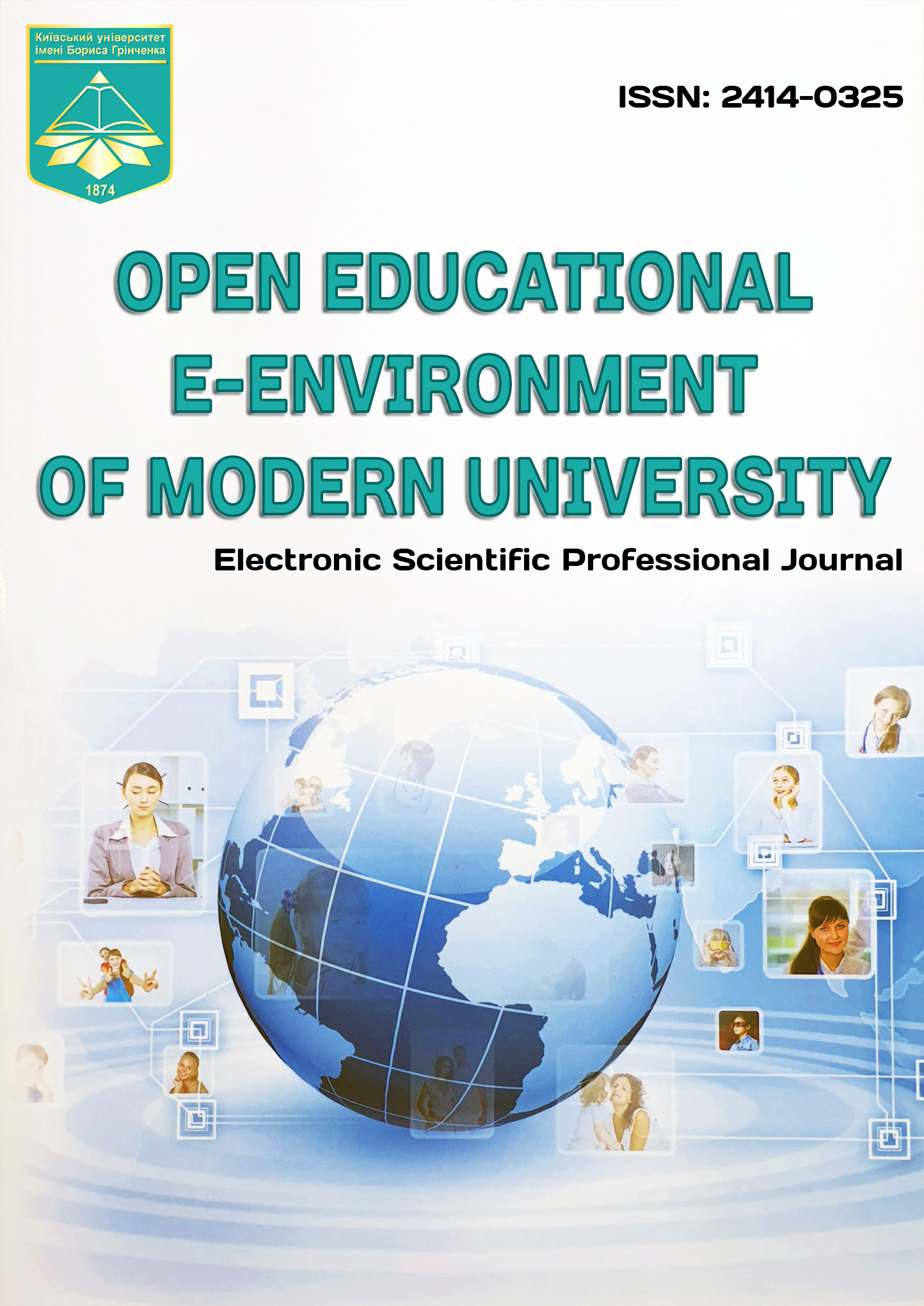EVALUATION OF MICROSOFT TEAMS AS A TOOL FOR SYNCHRONOUS INTERACTION DURING DISTANCE AND HYBRID LEARNING
DOI:
https://doi.org/10.28925/2414-0325.2023.141Keywords:
Microsoft Teams; instrumental support; synchronous interaction; distance learning; hybrid learningAbstract
After the outbreak of the COVID-19 pandemic in 2019 and the beginning of the war in the country, educational institutions switched to online learning using tools for organizing and holding video conferences, ensuring synchronous and asynchronous interaction of participants in the educational process. This article offers definitions of advantages (organization of various types of educational activities online; organization of effective collaboration; provision of access to various types of educational content; organization of reflection and estimation) and disadvantages (unstable work and dependence on Internet access; inconvenience of use on mobile devices; the need for skills in using the tool) using Microsoft Teams for synchronous interaction during distance and hybrid learning. The authors developed criteria and indicators for evaluating Microsoft Teams as a tool for synchronous interaction in modern conditions, such as functionality, reliability, effectiveness, interaction, accessibility, security and privacy, technical support and assistance. An example of a scheme of synchronous interaction when organizing an educational activity using Microsoft Teams is given, namely: creating a meeting room, inviting students to an online class, creating a meeting class (lecture, laboratory work, discussion, class recording), uploading various types of educational content, placing an announcement or a post, assignment assessment, or test. 17 scientific and pedagogical workers who have practical experience of using Microsoft Teams as a tool of synchronous interaction during distance and hybrid studies were involved for expert evaluation according to the specified criteria and indicators. The provided assessment of the capabilities of Microsoft Teams for synchronous interaction shows that the most significant indicators are the presence of a function for organizing and supporting synchronous interaction between participants in the educational process (0.09); the ability to interact with video and audio content to improve understanding and assimilation of educational material in real time (0.08); availability of tools for setting up interaction and collaboration in synchronous mode (interactive whiteboard, screen sharing, various types of documents) (0.08).
Downloads
References
Salta, K., Paschalidou, K., Tsetseri, M., Koulougliotis, D. Shift From a Traditional to a Distance Learning Environment during the COVID-19 Pandemic. Science & Education. 2022. vol. 31(1), pp. 93-122. URL: https://doi.org/10.1007/s11191-021-00234-x (date of access: 07.02.2023).
Глазунова, O., Корольчук, В., Волошина, T. Міждисциплінарний проєкт як засіб формування інтегральної компетентності майбутніх ІТ-фахівців. Наукові записки Тернопільського національного педагогічного університету імені Володимира Гнатюка. Серія: педагогіка, (1). 2019. c.136-148. URL: https://doi.org/10.25128/2415-3605.19.1.18 (дата звернення:10.02.2023).
Dash, S., Samadder, S., Srivastava, A., Meena, R., Ranjan, P. Review of Online Teaching Platforms in the Current Period of COVID-19 Pandemic. Indian Journal of Surgery. 2022. vol. 84, pp.12-17. URL: https://doi.org/10.1007/s12262-021-02962-4 (date of access: 07.02.2023).
Karthikeyan, D. Assessing the effectiveness of Microsoft Teams during COVID-19 for online learning: A students’ perceptive. In book: Efficacy of Microsoft Teams during COVID-19- A Survey. 2020. pp. 479-495. Edition: 1 Chapter: 26.
Іванькова, Н. А., Рижов, О. А., Андросов, О. І. Алгоритм формування групового та персонального навчального середовища засобами структурування освітнього простору університету на базі сервісів MS Office365 та MS Teams. Електронне наукове фахове видання “Відкрите освітнє е-середовище сучасного університету”, (9). 2020. c. 26-40. URL: https://doi.org/10.28925/2414-0325.2020.9.3 (дата звернення 10.02.2023).
Sarerusaenye, I., Shahrinaz, I. Teaching Approach using Microsoft Teams: Case Study on Satisfaction versus Barriers in Online Learning Environment. Journal of Physics Conference Series, 1874(1):012020. 2021. URL: https://doi.org/10.1088/1742-6596/1874/1/012020 (date of access: 07.02.2023).
Mr. Mohammad Ali, Mr. Khan Mohammed Zaid, Mr. Sudhir A. Shegunshi. Effective Online Teaching Tools and Comparison (MS Teams, Cisco WebEx Meetings, Zoom & Google Meet), IJESC, August 2021, p. 28638-28650.
Herskowitz, N. Gartner Recognises Microsoft as Leader in Unified Communications as a Service and Meetings Solutions, Microsoft 365. 2021. Available online: https://www.microsoft.com/en-us/microsoft-365/blog/2021/10/25/gartner-recognizes-microsoft-as-leader-in-unified-communications-as-a-service-and-meetings-solutions/
Бересток, О. Синхронний та асинхронний режими електронного навчання: стратегії, методи, завдання. Техніка та освітні технології, 9 (1). 2021. с. 19-29. URL: https://doi.org/10.30929/2307-9770.2021.09.01 (дата звернення 10.02.2023).
Wichanpricha, Т. Synchronous Online Learning through Microsoft Teams at Tertiary Level: Academic English Course, Journal of Educational and Social Research, vol. 11(5). 2021. рр.123-140. URL: https://doi.org/10.36941/jesr-2021-0111 (date of access: 07.02.2023).
Al-Qora'n, L., Salem, OA, Gordon, N. Heuristic Evaluation of Microsoft Teams as an Online Teaching Platform: An Educators' Perspective. Computers, vol. 11(12). 2022. рр. 175-187. URL: https://doi.org/10.3390/computers11120175 (date of access: 10.02.2023).
Mohd Lutfi Bin Mohd Khidir, Saiful Nizam Bin Sa’ari, Abu Seman Bin Mohammad. Effectiveness of online learning with microsoft team applications in Polimas. EPRA International Journal of Environmental Economics, Commerce and Educational Management Journal, vol. 9(5). 2022. рр. 29-33. URL: https://doi.org/10.36713/epra10260 (date of access: 10.02.2023).
Published
How to Cite
Issue
Section
License
Copyright (c) 2023 Glazunova J., Korolchuk V., Voloshyna T., Sayapina T.

This work is licensed under a Creative Commons Attribution-NonCommercial-ShareAlike 4.0 International License.













1.jpg)








